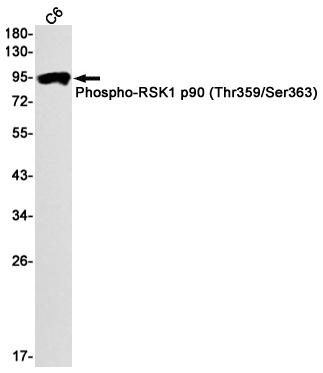Product Detail
Product NameRSK1 p90 (Phospho-Thr359/Ser363) Rabbit mAb
Clone No.S01-5B1
Host SpeciesRecombinant Rabbit
ClonalityMonoclonal
IsotypeRabbit IgG
PurificationAffinity Purified
ApplicationsWB
Species ReactivityHuman,Mouse,Rat
Immunogen DescA synthetic phosphopeptide corresponding to residues surrounding Thr359/Ser363 of human RSK1 p90
ConjugateUnconjugated
Other NamesKS6A1 MAPKAP-K1a RPS6KA1 RSK1 S6K-alpha 1
Accession NoSwiss-Prot:Q15418
GeneID:6195
Uniprot
Q15418
Gene ID
6195
Calculated MWCalculated MW: 83 kDa; Observed MW: 90 kDa
Concentration0.3 mg/ml
Formulation50mM Tris-Glycine(pH 7.4), 0.15M NaCl, 40% Glycerol, 0.01% Sodium azide and 0.05% BSA
StorageStore at 4˚C short term. Aliquot and store at -20˚C long term. Avoid freeze/thaw cycles.
Application Details
WB: 1/1000;
Western blot detection of Phospho-RSK1 p90 (Thr359/Ser363) in C6 cell lysates using Phospho-RSK1 p90 (Thr359/Ser363) Rabbit mAb(1:1000 diluted).Predicted band size:83kDa.Observed band size:90kDa.
Swiss-Prot Acc.Q15418.Serine/threonine-protein kinase that acts downstream of ERK (MAPK1/ERK2 and MAPK3/ERK1) signaling and mediates mitogenic and stress-induced activation of the transcription factors CREB1, ETV1/ER81 and NR4A1/NUR77, regulates translation through RPS6 and EIF4B phosphorylation, and mediates cellular proliferation, survival, and differentiation by modulating mTOR signaling and repressing pro-apoptotic function of BAD and DAPK1. In fibroblast, is required for EGF-stimulated phosphorylation of CREB1, which results in the subsequent transcriptional activation of several immediate-early genes. In response to mitogenic stimulation (EGF and PMA), phosphorylates and activates NR4A1/NUR77 and ETV1/ER81 transcription factors and the cofactor CREBBP. Upon insulin-derived signal, acts indirectly on the transcription regulation of several genes by phosphorylating GSK3B at 'Ser-9' and inhibiting its activity. Phosphorylates RPS6 in response to serum or EGF via an mTOR-independent mechanism and promotes translation initiation by facilitating assembly of the pre-initiation complex. In response to insulin, phosphorylates EIF4B, enhancing EIF4B affinity for the EIF3 complex and stimulating cap-dependent translation. Is involved in the mTOR nutrient-sensing pathway by directly phosphorylating TSC2 at 'Ser-1798', which potently inhibits TSC2 ability to suppress mTOR signaling, and mediates phosphorylation of RPTOR, which regulates mTORC1 activity and may promote rapamycin-sensitive signaling independently of the PI3K/AKT pathway. Mediates cell survival by phosphorylating the pro-apoptotic proteins BAD and DAPK1 and suppressing their pro-apoptotic function. Promotes the survival of hepatic stellate cells by phosphorylating CEBPB in response to the hepatotoxin carbon tetrachloride (CCl4). Mediates induction of hepatocyte prolifration by TGFA through phosphorylation of CEBPB (By similarity).
If you have published an article using product 52099, please notify us so that we can cite your literature.



 Yes
Yes



